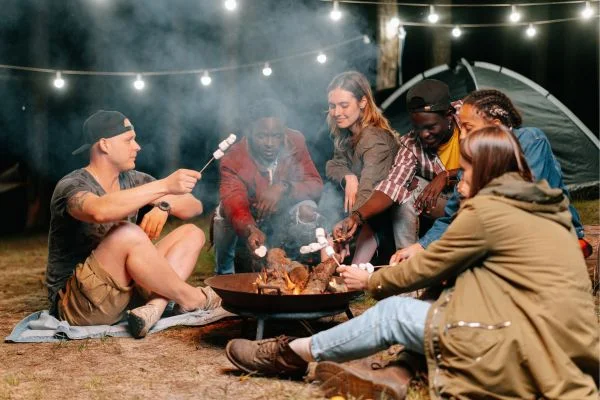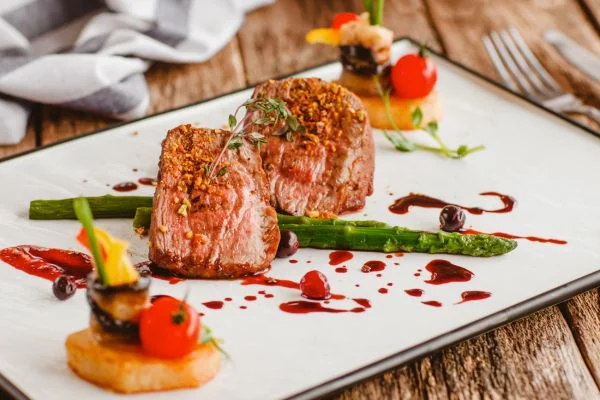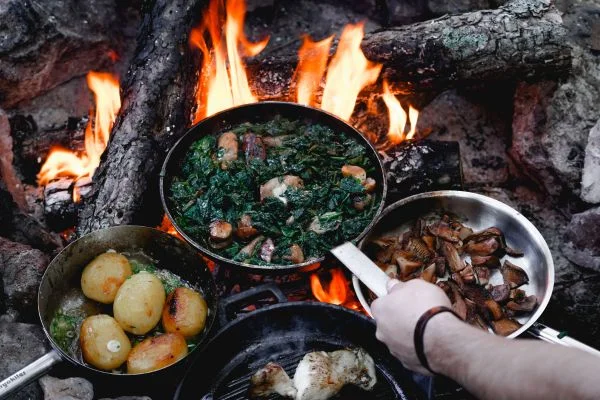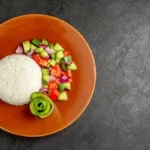Embarking on a camping expedition? The success of your outdoor adventure often hinges on one essential aspect: knowing what food to pack for camping. If you’re planning a camping trip and want to make sure you have everything you need, this list is a great place to start. The items on this list will help you avoid running out of food or spending money on expensive snacks in the wilderness. In addition, we’ve included various types of food so that there’s something for everyone, no matter what your preferences are.
Do You Know What Food To Pack For Camping:

Dried Fruits And Nuts:
Dried fruits and nuts are a great source of protein. They are light and compact, making them easy to pack. In addition, they have a long shelf life, so they will be okay if you forget about them in your backpack for too long.
Campfire Cooking:
Having a campfire for dinner is an exciting and traditional way to prepare meals. You can enjoy the warmth of the fire, connect with nature, and eat awesome food. To make your camping experience better, here are five campfire cooking methods:
Skewer and Grill:
The skewers should be packed with marinated meat or vegetables and the marinade. In a campfire, thread each of the skewers with the meat and cook them over open flames over the campfire. You may want to try chicken and vegetable skewers or even marshmallows for a sweet treat for your guests.
Foil Packets:
Using aluminum foil, you can wrap your favorite ingredients and cook them directly over the coals of the campfire. There are a variety of ingredients that you can use to make foil-packed meals, such as potatoes, onions, bell peppers, and sausage. If you like, you can add a few herbs and spices to your dish.
Dutch Oven Cooking:
You will need a Dutch oven, which is a versatile cast-iron pot with a lid that makes it easy to cook. As you can see, you can use it to cook stews, soups, chili, and even bake bread with it. Put it on top of the coals of the campfire and adjust the temperature by controlling the intensity of the fire.
Campfire Grate:
There are many campgrounds that provide campfire grates or grills that you can use to prepare a fire for your group. You can use them to cook food like hamburgers, hot dogs, and steaks on the grill. You don’t want to forget to bring the condiments and buns you prefer for a classic campfire meal.
Cast Iron Skillet:
There is no doubt that a cast-iron skillet is a valuable tool when it comes to cooking over a campfire. The pan can be used for cooking breakfast food like bacon and eggs, or it can be used to cook a variety of dinner foods such as stir fries or fajitas in one pan.
Ensure that fires are allowed at your campsite by checking the fire regulations. Don’t cook over an open flame unless you’re sure you’re doing it safely. You can enjoy meals with a unique smoky flavor while camping by cooking over a campfire.
Read More: What Food Should I Bring For 3 Days Camping?
Energy Bars And Granola:
When camping, energy bars, and granola are great options for breakfast. They provide a source of protein and carbohydrates, which helps to keep your blood sugar stable throughout the day. Both energy bars and granola can easily be packed into small containers or bags you can carry with you on the go.
You should know the answer to “what food to pack for camping?” In addition, they’re easy to prepare: add water! Or, if you want something more portable, try adding peanut butter or other nut butter on top of them when they’re in their snack form. And even though these foods have been around for ages now, they still hold up well against modern trends regarding taste and nutritional value—so don’t worry about getting bored with these options either!
Easy-To-Cook Meals:
There are several types of easy-to-cook meals that you can bring along on your camping trips.
- Oatmeal: Rice, pasta, and oatmeal are some of the most versatile ingredients in your kitchen, as they can be prepared quickly over a stove or campfire. You’ll also want to pack some spices to flavor them up.
- Instant soups: Soups are another great option for quick meals when camping. They’re easy to make and require less cleanup than other options like macaroni and cheese or canned tuna salad sandwiches. Just add hot water right out of the bag!
- Pancake mix with syrup: Pancakes always taste better when made outdoors—and they’re even more accessible to prepare than regular pancakes because all you have to do is add water! Pack some syrup if you run out or forget yours at home (or want something different).
- Dried beans: Dried beans don’t take up much space in your cooler but are nutritious and filling once mixed with spices or chopped veggies from nature’s pantry—and all it takes is simmering them on low heat until tender!

Spices, Condiments, And Sauces:
You can turn a bland meal into something delicious with the right spices, condiments, and sauces. Bring along some dried herbs and spices that you love so that you can season your food like you usually would at home. If any spice or seasoning is missing from the list below, add it to your bag!
- Salt (kosher or sea salt)
- Black pepper (whole peppercorns)
- Cayenne pepper (cayenne powder)
- Onion powder
- Garlic powder
No-Cook Camping Meals:
You can enjoy delicious food without the need for a campfire or stove with no-cook camping meals. They’re easy, don’t require a lot of preparation, and are perfect for hot summer days. Camping meal ideas you don’t have to cook:
Cold Pasta Salad:
You should cook the pasta ahead of time, let it cool, and store it in the refrigerator. You can mix it with chopped vegetables like tomatoes, cucumbers, bell peppers, and olives and then serve the salad. Protein can be added to the dish by adding some precooked chicken or canned tuna. Dress the salad with your favorite dressing or vinaigrette of your choice.
Wraps or Sandwiches:
There are many ways to pack your lunch, including tortillas, pita bread, or your favorite sandwich bread, as well as fillings, such as deli meats, cheeses, lettuces, and spreads, such as mayonnaise or mustard. For a fresh and satisfying meal, prepare your wraps or sandwiches on-site for a quick and easy service.
Hummus and Veggie Platter:
It is a good idea to bring along some hummus (either store-bought or homemade) and a variety of fresh vegetables like baby carrots, cherry tomatoes, cucumber slices, and bell pepper strips along with you. Enjoy the dip, and have a great time!
Caprese Skewers:
The best way to prepare these skewers is to use cherry tomatoes, mozzarella cheese balls, and fresh basil leaves. You can enjoy a tasty and refreshing light meal or snack by drizzling olive oil and balsamic glaze over the top.
Canned Salad:
In the supermarket, you can purchase canned salads such as tuna salad or chicken salad that are ready to eat. If you are looking for an easy and protein-rich meal, you can serve them on crackers, in a tortilla, or on a bed of lettuce with crackers.
The best part about these no-cook camping meals is that they’re easy to prepare and versatile. You can customize them to your taste and dietary needs. In addition, they require minimal cleanup, making them convenient for camping trips when you want to spend more time outdoors. Now you know what food to pack for camping in different styles.
Read More: How To Cook Food When Camping?
FAQs About What Food To Pack For Camping
You can enjoy delicious meals outdoors with campfire cooking, a fun and rewarding part of your camping experience. Follow the campground rules and regulations about fires and cooking.
Is campfire cooking safe?
When done right, campfire cooking can be safe. Keep campground rules and fire regulations in mind. Make sure you maintain a safe distance from the fire, use fire rings or grates, and always supervise the fire while it is burning. Fire extinguishers and water sources should always be nearby in case of fire.
What are some campfire cooking essentials?
A cast-iron skillet and Dutch oven are essential campfire cooking equipment, along with long-handled cooking utensils, heat-resistant gloves, aluminum foil for foil packets, and a campfire grate or grill.
How do I control the temperature of a campfire for cooking?
You can control the temperature by adjusting the height of your cooking equipment or how far you are from the fire. You can reduce the heat in a Dutch oven by raising it off the coals. As well as controlling the size and intensity of the fire, you can add or remove wood.
Can I cook anything over a campfire?
Some foods work better over a campfire than others, though. Try skewers, foil packets, and one-pot meals designed for campfire cooking. Make sure you don’t bring anything fragile, or that needs to be kept at a precise temperature.
What are some easy campfire recipes for beginners?
If you’re a beginner, try foil-packed potatoes with herbs, campfire chili, or s’mores for dessert. New campfire cooks will love these recipes because they require minimal prep and equipment.
Conclusion
We hope this list has helped you think about what food to pack for camping. The key is to choose foods that are easy to cook and store but still tasty and nutritious. We also recommend picking up a few things from the supermarket before heading out into nature so that you’ll have something simple like peanut butter on hand in case there aren’t any other options available near your campsite.



